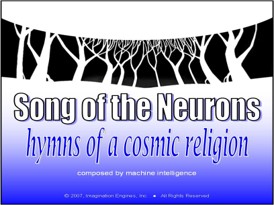Machine Generated Music
2007, Song of the Neurons
IEI's efforts at machine-generated music began in 1994, resulting in 11,000 musical hooks that were filed as copyrighted works. Later, in 1997, a Creativity Machine was enlisted to write much of the background music for a documentary entitled, "Creative Computers," part of the Noorderlicht program on the Dutch television network, VPRO. Apart from opening and closing theme music, the rest is synthetic music generated by a Creativity Machine.Up until this point, synthetic music was created through the slow and arduous statistical task of discerning what note should follow another, without any coordination of first, last, and all notes in between. As an alternative, genetic programming could produce at most 10 note hooks. In the former case, humans were the ultimate judge of the music's quality. In the latter case of genetic programming, artificial neural nets could be used to model human tastes, but the generative component was prone to combinatorial explosion.
In contrast, our founder built a musical Creativity Machine in 2005 whose generator net produced candidate melodies as a discriminator net reinforced especially promising tunes. Intermittently, the discriminator would observe the facial expression of a human volunteer to iteratively refine the Creativity Machine's musical output. From this experiment IEI released an album of 14 original musical compositions called Song of the Neurons: Hymns of a Cosmic Religion".
As an interesting aside, the album's appeal was largely a function of any qualifications made preceding its play. If nothing was mentioned about an AI involvement, it was received as interesting and entertaining. Revealing the music's origin, it was largely rejected and sometimes even reviled, especially among musicians.

